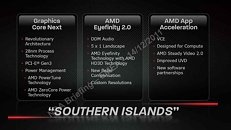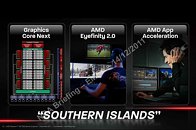- Joined
- Oct 9, 2007
- Messages
- 47,243 (7.55/day)
- Location
- Hyderabad, India
| System Name | RBMK-1000 |
|---|---|
| Processor | AMD Ryzen 7 5700G |
| Motherboard | ASUS ROG Strix B450-E Gaming |
| Cooling | DeepCool Gammax L240 V2 |
| Memory | 2x 8GB G.Skill Sniper X |
| Video Card(s) | Palit GeForce RTX 2080 SUPER GameRock |
| Storage | Western Digital Black NVMe 512GB |
| Display(s) | BenQ 1440p 60 Hz 27-inch |
| Case | Corsair Carbide 100R |
| Audio Device(s) | ASUS SupremeFX S1220A |
| Power Supply | Cooler Master MWE Gold 650W |
| Mouse | ASUS ROG Strix Impact |
| Keyboard | Gamdias Hermes E2 |
| Software | Windows 11 Pro |
We've already been through the specifications of HD 7970 "Tahiti" in some detail that matters to those who can draw a performance hunch looking at them. This latest slide shows you the feature-set this GPU comes with. To begin with, there are three main categories of feature updates: Graphics CoreNext, AMD Eyefinity 2.0, and AMD APP Acceleration. AMD claims CoreNext to be a "revolutionary" new architecture that changes the way the GPU crunches numbers.
For the past five generations (since Radeon HD 2000), AMD GPUs have used the VLIW (very-long instruction word) core arrangement. Even the latest VLIW4 introduced by Radeon HD 6900 series, was an evolution, than a revolution of that. CoreNext replaces VLIW stream processors with super-scalar Graphics Compute cores. This should translate to higher performance per mm² die-area, resulting in smaller GPUs, giving AMD room for greater cost-cutting if the competition from NVIDIA for this generation takes effect. The GPU itself is built on TSMC's new 28 nm silicon fabrication process. Next up, AMD confirmed support for PCI-Express 3.0 interface, that nearly doubles system bus bandwidth over the previous generation.


To manage power, there's AMD's PowerTune technology that adjusts clock speeds both ways (both below and above specifications), to remain within a set power envelope. Then there's talk of ZeroCore technology, a feature that completely turns off the GPU when the operating system instructs it to "turn off monitors" when idling. This reduces power draw of the graphics card to under 3W, that's a 10X idle power draw reduction over the previous generation. This feature is also said to send non-primary GPUs when in a CrossFire setup (the second, third and fourth) to ZeroCore state while keeping the primary GPU (to which displays are connected) awake, when the user isn't running 3D-intensive tasks.
Moving on to Eyefinity 2.0, there's talk of some big changes. First is DDM audio, a directional audio system that outs independent 7.1 channel audio streams through each of the HDMI and DisplayPort connectors. When you move an audio output-producing application's window from one display to another, its audio stream dynamically shifts from one connector to another. A practical application of this could be running an extra-long HDMI cable from your PC to your living room. We'll leave your creativity to do the rest of the thinking. Eyefinity 2.0 will keep support for 5 x 1 landscape arrangement. The system will now support HD3D, display of stereoscopic 3D from each member display while compensating for the display's angle to the user's perspective and bezel.
Moving on, the APP runtime gets some feature updates that take advantage of the more powerful GPU compute architecture these GPUs come with. It will be designed for [heavy] computing loads (bitcoin magnets?), will feature SteadyVideo 2.0, which will further enhance videos after compensating the camera shake, Improved UVD could mean more video decoding features. Home 3D video is the next big thing, so the new UVD engine could address some performance issues related to that. Finally AMD will expand its developer ecosystem, more applications will support AMD APP.
View at TechPowerUp Main Site
For the past five generations (since Radeon HD 2000), AMD GPUs have used the VLIW (very-long instruction word) core arrangement. Even the latest VLIW4 introduced by Radeon HD 6900 series, was an evolution, than a revolution of that. CoreNext replaces VLIW stream processors with super-scalar Graphics Compute cores. This should translate to higher performance per mm² die-area, resulting in smaller GPUs, giving AMD room for greater cost-cutting if the competition from NVIDIA for this generation takes effect. The GPU itself is built on TSMC's new 28 nm silicon fabrication process. Next up, AMD confirmed support for PCI-Express 3.0 interface, that nearly doubles system bus bandwidth over the previous generation.


To manage power, there's AMD's PowerTune technology that adjusts clock speeds both ways (both below and above specifications), to remain within a set power envelope. Then there's talk of ZeroCore technology, a feature that completely turns off the GPU when the operating system instructs it to "turn off monitors" when idling. This reduces power draw of the graphics card to under 3W, that's a 10X idle power draw reduction over the previous generation. This feature is also said to send non-primary GPUs when in a CrossFire setup (the second, third and fourth) to ZeroCore state while keeping the primary GPU (to which displays are connected) awake, when the user isn't running 3D-intensive tasks.
Moving on to Eyefinity 2.0, there's talk of some big changes. First is DDM audio, a directional audio system that outs independent 7.1 channel audio streams through each of the HDMI and DisplayPort connectors. When you move an audio output-producing application's window from one display to another, its audio stream dynamically shifts from one connector to another. A practical application of this could be running an extra-long HDMI cable from your PC to your living room. We'll leave your creativity to do the rest of the thinking. Eyefinity 2.0 will keep support for 5 x 1 landscape arrangement. The system will now support HD3D, display of stereoscopic 3D from each member display while compensating for the display's angle to the user's perspective and bezel.
Moving on, the APP runtime gets some feature updates that take advantage of the more powerful GPU compute architecture these GPUs come with. It will be designed for [heavy] computing loads (bitcoin magnets?), will feature SteadyVideo 2.0, which will further enhance videos after compensating the camera shake, Improved UVD could mean more video decoding features. Home 3D video is the next big thing, so the new UVD engine could address some performance issues related to that. Finally AMD will expand its developer ecosystem, more applications will support AMD APP.
View at TechPowerUp Main Site
Last edited:






